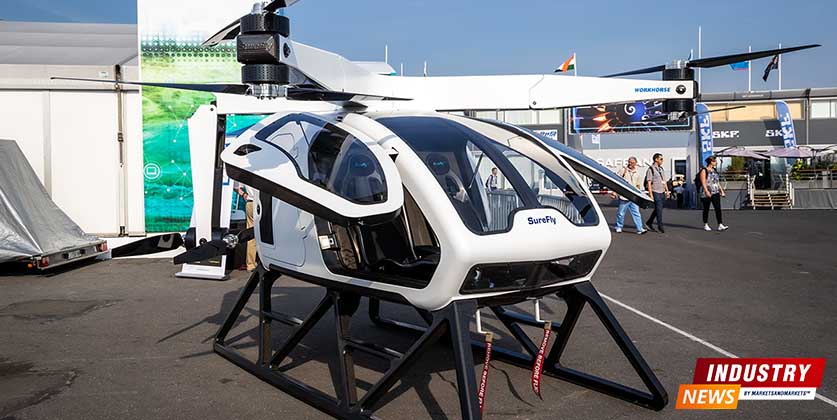Investments worth Billions Give Boost to Vertiports and eVTOLs

This News Covers
- Flying Taxis to be Made in Ohio, Home of Wright Brothers
- Lilium Begins Fuselage Assembly for Type Certification of eVTOL
- Impacts and considerations
- Which are the top companies in Vertiport market across the world?
- Investments and Economic Activity in the Vertiport Market
- Top economic developments that are boosting eVTOL and Vertiports
- Some of the vertiports from across the world
- Manufacturing and Supply Chain of eVTOL
- Top Countries in eVTOL Manufacturing
- Interconnected Industries in eVTOL Manufacturing
- Curated Insights on eVTOL and Vertiports from MarketsandMarkets
Vertiports have the potential to significantly transform aviation, reshaping the way people travel and interact with urban environments. They are pivotal in shaping the future of the aviation industry, acting as the backbone for the deployment of VTOL and eVTOL aircraft. They hold the potential to transform urban landscapes, drive economic growth, and propel advancements in aviation technology and services. The significance of vertiports extends beyond the aviation sector, impacting urban development, sustainability, and societal mobility patterns, making them a key component in the evolution of global transportation systems.
MarketsandMarkets welcomes the developments, investments in Vertiport market in 2023 and we look at these here.
Flying Taxis to be Made in Ohio, Home of Wright Brothers
Joby Aviation, in collaboration with the state of Ohio, is set to produce electric vertical takeoff and landing (eVTOL) aircraft, or "flying taxis," at Dayton International Airport. The aircraft are designed to transport a pilot and four passengers at speeds of up to 321.87 km/h and cover a distance of up to 160.93 km. The $500 million project is supported by up to $325 million in payments from the state of Ohio and aims to deliver up to 500 aircraft a year, creating 2,000 jobs. Joby plans to integrate these aircraft into aerial ridesharing networks by 2025.
Lilium Begins Fuselage Assembly for Type Certification of eVTOL
Lilium, a German eVTOL manufacturer, is progressing towards a global commercial launch by 2026. The company has begun assembling fuselages for its seven-seater Lilium Jet, aiming for European Union Aviation Safety Agency (EASA) type certification by 2025. The aircraft, designed to ferry passengers between towns and inner cities, has received substantial purchase orders, including a $1 billion deal with Brazilian airline Azul for 220 aircraft. Lilium has accrued nearly $1.34 billion in investments and is planning an eVTOL vertiport in Orlando.
These developments in the aviation and vertiport sector signify a paradigm shift in transportation, potentially revolutionizing urban mobility and altering economic landscapes.
Impacts and considerations
Economic Diversification and Job Creation
The development of eVTOL technology will lead to economic diversification, especially in regions like Ohio, fostering innovation and creating jobs in manufacturing, technology, and service sectors. The influx of investments and the creation of new facilities will stimulate local economies, leading to increased economic activity and employment opportunities.
Urban Mobility and Infrastructure
The introduction of flying taxis will redefine urban mobility, offering efficient, fast, and sustainable transportation alternatives. This will necessitate the development of new infrastructures like vertiports and charging stations
Which are the top companies in Vertiport market across the world?
The top companies in the vertiport market include
Skyports Infrastructure Limited (UK)
UrbanV S.P.A (Italy)
Ferrovial (Spain)
Groupe ADP (France)
Urban-Air Port Ltd (UK)
Bayards Vertiport Solutions (Netherlands)
Vports (Canada)
Skyportz (Australia)
Lilium Aviation GmbH (Germany)
Volatus Infrastructure LLC (US)
Volocopter GmbH (Germany)
EHang (China)
Joby Aviation (US)
Airbus
Boeing
Bell
These companies are globally established players dominating the vertiport industry, contributing to the development and implementation of vertiport solutions and technologies. They are involved in various aspects of the vertiport market, including design, manufacturing, infrastructure development, and operation of vertiports, and are expected to play a significant role in the growth of the urban air mobility sector.
Investments and Economic Activity in the Vertiport Market
The vertiport market is at the nexus of innovation, investment, and economic activity, shaping the future of urban mobility and the aviation industry. The convergence of technological advancements, strategic partnerships, regulatory progress, and consumer demand is propelling the market forward, heralding a new era of sustainable and efficient urban transportation. The transformative impact of vertiports is multifaceted, encompassing economic revitalization, lifestyle evolution, environmental conservation, and transportation paradigm shift, positioning vertiports as a revolutionary development in the global transportation ecosystem.
With a surge in investments and economic activities, indicative of the growing recognition of its transformative potential in urban mobility and the broader aviation sector. Vertiports, as defined by Wiktionary, are specialized facilities designed for aircraft that operate with vertical take-off and landing (VTOL) capabilities, such as helicopters and electric VTOL (eVTOL) aircraft.
Strategic Investments and Developments
The market is characterized by substantial financial commitments from various stakeholders, including aviation companies, governments, and private investors. These investments are channeled towards the development of state-of-the-art vertiport facilities, research and development of eVTOL technologies, and the establishment of partnerships and collaborations aimed at advancing Urban Air Mobility (UAM) solutions, as outlined in Wikipedia.
Innovation and Technological Advancements
The influx of investments is fueling innovation and technological advancements in eVTOL aircraft, as detailed in Wikipedia, and vertiport infrastructure. The development of sophisticated and environmentally friendly eVTOL aircraft is pivotal for the operationalization of vertiports, and the ongoing innovations are enhancing the safety, efficiency, and sustainability of these aircraft, making them viable options for urban transit.
Market Expansion and Diversification
The economic activities in the vertiport market are not confined to specific regions or players but are widespread, reflecting a global interest and belief in the prospects of vertiports and UAM. The market is expanding to include diverse stakeholders, ranging from aviation giants to startups, each contributing to the market's dynamism and growth. This expansion is accompanied by the exploration of various business models and services, including aerial ridesharing and air taxi services, broadening the market's scope and appeal.
Economic Stimulation and Job Creation
The development of vertiports is acting as a catalyst for local economic growth and job creation. The construction and operationalization of vertiport facilities necessitate a skilled workforce, stimulating employment opportunities in various domains, including engineering, construction, operations, and customer service. Additionally, the presence of vertiports can increase the attractiveness and value of the surrounding areas, fostering economic development and revitalization.
Regulatory Evolution and Standardization
The burgeoning vertiport market is prompting the evolution of regulatory frameworks and the establishment of standards to govern the safe and equitable use of vertiports and UAM services. The collaboration between industry players and regulatory bodies is crucial for addressing the challenges and uncertainties associated with the integration of vertiports into existing urban landscapes and airspace. The development of comprehensive and harmonized regulations is instrumental in ensuring the long-term success and acceptance of vertiports.
Consumer Behavior and Lifestyle Impact
The availability and accessibility of vertiports and associated services are influencing consumer preferences and lifestyles. The convenience and efficiency offered by vertiports are altering travel behaviors and expectations, potentially leading to a societal shift towards aerial mobility solutions. The consumer-centric approach and the emphasis on user experience are driving service enhancements and customization, catering to the diverse needs and preferences of the users.
Top economic developments that are boosting eVTOL and Vertiports
It is evident that investments and economic activities are indeed increasing in the vertiport market.
Joby Aviation's Investments in Ohio
Joby Aviation is making substantial investments, planning to invest up to $500 million in a new facility in Dayton, Ohio, for mass-producing electric air taxis. This investment is aimed at establishing a manufacturing facility capable of producing up to 500 eVTOL aircraft per year, indicating significant economic activity and commitment to the development of the vertiport and eVTOL sector.
First Dubai Vertiport Construction
The initiation of the construction of the first Dubai vertiport in 2024, developed by VPorts, is another indicator of growing economic activities in the vertiport market. The development of a 37,000 square meters vertiport in Dubai South, focusing on Advanced Air Mobility (AAM), signifies substantial investment and development in the region.
Urban-Air Port's Partnership in Korea
The partnership between Urban-Air Port, Hanwha Systems, and Korea Airports Corporation for vertiport development in Korea emphasizes the increasing collaborations and developments in sustainable air mobility and vertiport infrastructure solutions, reflecting heightened economic activities and interests in the sector.
Archer Aviation's FAA Approval and Funding
Archer Aviation securing FAA airworthiness certification and $215 million in funding from entities like Stellantis, United, Boeing, and others, with total funding over $1.1 billion, is a clear indication of the growing investments and confidence in the vertiport and urban air mobility market.
These developments collectively illustrate a trend of escalating investments, partnerships, and economic engagements in the vertiport market, highlighting the perceived potential and value of vertiports and associated technologies in transforming urban mobility and the aviation industry.
Some of the vertiports from across the world
The development of vertiports is essential for the commercialization of eVTOL aircraft. Vertiports will provide a place for eVTOL aircraft to take off and land, and they will also provide passengers and cargo with a convenient way to access eVTOL transportation.
Skyports Droneport Singapore
This vertiport is located in the Marina Bay area of Singapore and is used for drone testing and operations.
Skyports Vertiport Liverpool
This vertiport is located in Liverpool, UK, and is used for air taxi operations.
Skyports Vertiport Liverpool
EHang Urban Air Mobility Terminal Guangzhou This vertiport is located in Guangzhou, China, and is used for air taxi operations.
EHang Urban Air Mobility Terminal Guangzhou
Volatus Infrastructure Vertiport Fort Worth This vertiport is located in Fort Worth, Texas, and is used for air taxi and cargo operations.
Volatus Infrastructure Vertiport Fort Worth
Urban-Air Port Paris This vertiport is located in Paris, France, and is used for air taxi operations.
These are just a few of the vertiports that are currently located in the world. As the eVTOL industry continues to grow, we can expect to see even more vertiports being built and deployed in the coming years.
In addition to the vertiports listed above, there are a number of other vertiports that are currently under development or construction around the world. For example, Skyports is developing vertiports in London, Dubai, and Los Angeles. Urban-Air Port is developing vertiports in London, Coventry, and Los Angeles. Ferrovial is developing vertiports in Miami, Dallas, and Madrid. Groupe ADP is developing vertiports in Paris and Singapore.
Manufacturing and Supply Chain of eVTOL
The manufacturing and supply chain of electric vertical takeoff and landing (eVTOL) aircraft are intricate processes involving multiple stakeholders, industries, and technologies. The eVTOL manufacturing process is a convergence of advanced aerospace engineering, innovative design principles, and cutting-edge technologies, aimed at creating aircraft capable of vertical takeoff and landing while ensuring safety, efficiency, and sustainability.
Design and Development
The journey of eVTOL manufacturing begins with design and development, where aerospace engineers and designers conceptualize the aircraft, focusing on aerodynamics, weight, propulsion systems, and flight controls. Advanced software tools and simulation technologies are employed to optimize design parameters and assess aircraft performance under various conditions.
Material Selection
Material selection is crucial in eVTOL manufacturing, with emphasis on lightweight and durable materials such as composites and alloys, to enhance aircraft performance and fuel efficiency. The choice of materials impacts the aircraft's weight, structural integrity, and overall operational efficiency.
Component Manufacturing
eVTOLs consist of numerous components, including rotors, propellers, batteries, motors, avionics, and landing gear, each requiring specialized manufacturing processes. Suppliers and subcontractors, often from diverse industries, are engaged to produce these components to precise specifications.
Supply Chain Integration
The integration of the supply chain is vital for the timely and cost-effective production of eVTOLs. It involves the coordination and synchronization of various entities, including suppliers, manufacturers, and logistics providers, to ensure the seamless flow of components, materials, and information throughout the production cycle.
Assembly and Testing
Once components are manufactured and procured, they are assembled to form the complete aircraft. The assembly process is followed by rigorous testing and quality assurance to validate the aircraft's performance, reliability, and compliance with regulatory standards.
Certification and Compliance
eVTOL manufacturers work closely with aviation authorities to obtain the necessary certifications and approvals, ensuring that the aircraft meet safety and airworthiness criteria. Compliance with regulatory requirements is paramount for the commercialization and operation of eVTOLs.
Top Countries in eVTOL Manufacturing
The manufacturing and supply chain of eVTOL aircraft are multifaceted and collaborative endeavors, involving diverse industries and stakeholders. The convergence of advanced technologies, specialized components, and innovative design principles is shaping the future of eVTOL manufacturing. The interdependence of various industries underscores the holistic nature of eVTOL development, reflecting the interconnectedness of technological, economic, and infrastructural elements.
Several countries are emerging as leaders in eVTOL manufacturing, driven by investments, innovations, and regulatory advancements
United States
Home to numerous eVTOL companies and startups, with significant investments and developments in eVTOL technologies.
Germany
A hub for aerospace innovation, with several companies focusing on the development of eVTOL aircraft.
China
Witnessing rapid advancements in eVTOL manufacturing, supported by government initiatives and domestic demand.
United Kingdom
Hosting several eVTOL projects and companies, with a focus on sustainable and urban air mobility solutions.
Brazil
Leveraging its strong aerospace industry to venture into eVTOL manufacturing and development.
South Korea
Investing in research and development of eVTOL technologies and urban air mobility solutions.
Singapore
Emerging as a center for eVTOL research and development, with a strategic focus on urban air mobility.
Interconnected Industries in eVTOL Manufacturing
The development of electric vertical takeoff and landing (eVTOL) aircraft is a complex, multifaceted endeavor, involving the collaboration of various industries, each bringing its specialized knowledge and skills to the table. It's crucial for professionals in the aviation sector to comprehend the diverse range of industries that are instrumental in shaping the eVTOL landscape, each contributing significantly to the advancements in this field.
Understanding the intricate interplay of these industries is essential for anyone involved in the eVTOL sector. Each industry brings its unique insight and expertise, contributing to the collective effort to realize the vision of urban air mobility. The collaboration and integration of these diverse sectors are paving the way for innovative, sustainable, and efficient air travel solutions, reshaping the future of urban transportation.
Aerospace Industry
The aerospace industry is central to eVTOL manufacturing, overseeing the design, engineering, and production of the aircraft. This industry applies advanced aerospace engineering and innovative design principles to develop practical and efficient eVTOL aircraft, ready to meet the demands of urban air mobility.
Material Science Industry
The material science industry plays a crucial role in providing advanced materials and composites that are essential for constructing lightweight and durable eVTOL structures. This industry focuses on ensuring the structural integrity and operational efficiency of the aircraft while also considering environmental impacts.
Battery and Energy Storage Industry
This industry is vital for developing and supplying the energy storage solutions required for electric propulsion in eVTOLs. It focuses on enabling efficient energy use to power the aircraft, ensuring the feasibility of electric flight.
Electronics and Avionics Industry
Specialists in electronics and avionics are responsible for creating sophisticated systems necessary for flight control, navigation, and communication in eVTOLs. They develop the essential electronic components that allow for the safe and precise operation of the aircraft in urban environments.
Software and Simulation Industry
The software and simulation industry provides essential tools and solutions for design optimization and performance assessment of eVTOLs. It aids in refining the design and enhancing the safety and efficiency of the aircraft through advanced software solutions and simulation technologies.
Logistics and Transportation Industry
This industry is responsible for the efficient movement of components and finished products within the supply chain. It ensures the smooth flow of materials and products, optimizing the overall manufacturing process.
Maintenance, Repair, and Overhaul (MRO) Industry
The MRO industry is crucial for providing the necessary support services for the maintenance and repair of eVTOL aircraft. It ensures the reliability and longevity of the aircraft, maintaining optimal operational conditions.
Real Estate and Infrastructure Industry
This industry is involved in developing the necessary infrastructure, such as vertiports, required for the operation of eVTOLs. It focuses on creating the foundational structures that will accommodate the landing, takeoff, and charging needs of eVTOL aircraft.
Curated Insights on eVTOL and Vertiports from MarketsandMarkets
The vertiports market is experiencing substantial growth, with projections estimating it to escalate from USD 0.4 billion in 2023 to USD 10.7 billion by 2030, marking a CAGR of 62.1% from 2023 to 2030. This surge is primarily attributed to advancements in technology and the initiation of smart city projects globally.
Charging Stations
Charging stations are anticipated to witness the highest growth in the vertiports market. The expansion of Advanced Air Mobility (AAM) infrastructure is significant, with cities globally allocating resources to establish vertiports, areas designated for air taxis, and eVTOL aircraft to operate. The demand for sustainable transportation solutions and the need to support the expansion of electric AAM vehicle operations are fueling the rapid growth of charging stations.
Rooftop/Elevated Vertiports
Rooftop/elevated vertiports are projected to experience the highest growth, offering innovative solutions for advanced air mobility by utilizing existing infrastructure in densely populated areas. These vertiports are space-efficient and reduce the need for extensive ground space, driven by the increasing demand for efficient urban transportation and advancements in eVTOL technology.
Vertipads Segment
The vertipads segment is expected to have the largest share and highest CAGR during the forecast period, driven by the rising demand for efficient and eco-friendly transportation solutions in urban areas. Continuous advancements in VTOL technology and electric aviation are further propelling the growth of vertipads.
North America's Dominance
North America is anticipated to have the largest share in the vertiports market in 2023, driven by technological advancements, increased demand for efficient transportation, and government support. The region has become a hub for several established aerospace companies and innovative startups aiming to transform advanced air mobility.
Major Market Players
Major players operating in the vertiports market include Bayards Vertiport Solutions (Netherlands), Vports (Canada), Skyportz (Australia), Skyways (US), and Volatus Infrastructure LLC (US). These companies have robust manufacturing facilities and extensive distribution networks across various regions.
Diverse Applications
The vertiports market in North America is also driven by a wide array of applications, including air taxis, cargo delivery, and emergency services, expected to bring about a transformative shift in air mobility, revolutionizing the future of transportation in the region.
The vertiports market is poised for significant growth, driven by technological advancements, the rise in sustainable transportation solutions, and the development of infrastructure to support eVTOL operations. The market is witnessing the emergence of innovative solutions such as rooftop/elevated vertiports and charging stations, catering to the evolving demands of urban air mobility. North America is leading the market, with substantial investments and developments in the vertiports sector, fostering innovation and growth in advanced air mobility.
GET AHEAD
Top Research Reports to Fuel Your Industry KnowledgeEditor's Pick


Information and Communication Technology
Insurtech Funding News - Coverdash raises USD 13.5 Million
PODCASTS

Sustainable Digital Transformation & Industry 4.0
Sanjay Kaul, President-Asia Pacific & Japan, Cisco, and host Aashish Mehra, Chief Research Officer, MarketsandMarkets, in conversation on unraveling 'Sustainable Digital Transformation and Industry 4.0'
11 July 2023|S2E12|Listen Now

Generative AI
Prasad Joshi, Senior Vice President-Emerging Technology Solutions, Infosys, and host, Vinod Chikkareddy, CCO, MarketsandMarkets, in exploring the recent advances in AI and the generative AI space.
7 Nov 2023|S2E13|Listen Now
Vertiport Market Growth
Download Whitepaper
2025: Urban mobility
Joby plans to integrate these aircraft into aerial ridesharing networks by 2025.
Feasible Impact
Vertiports will provide a place for eVTOL aircraft to take off and land, and they will also provide passengers and cargo with a convenient way to access eVTOL transportation.












